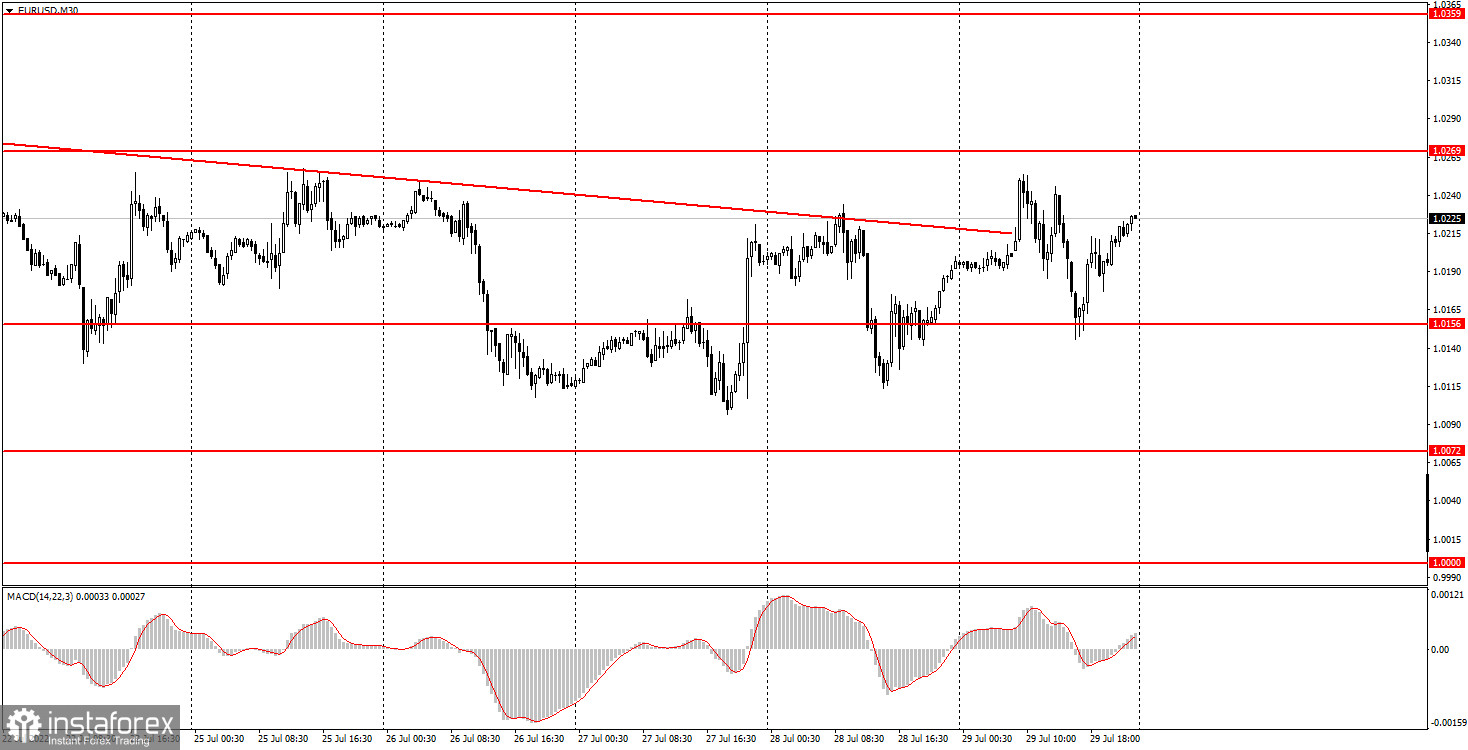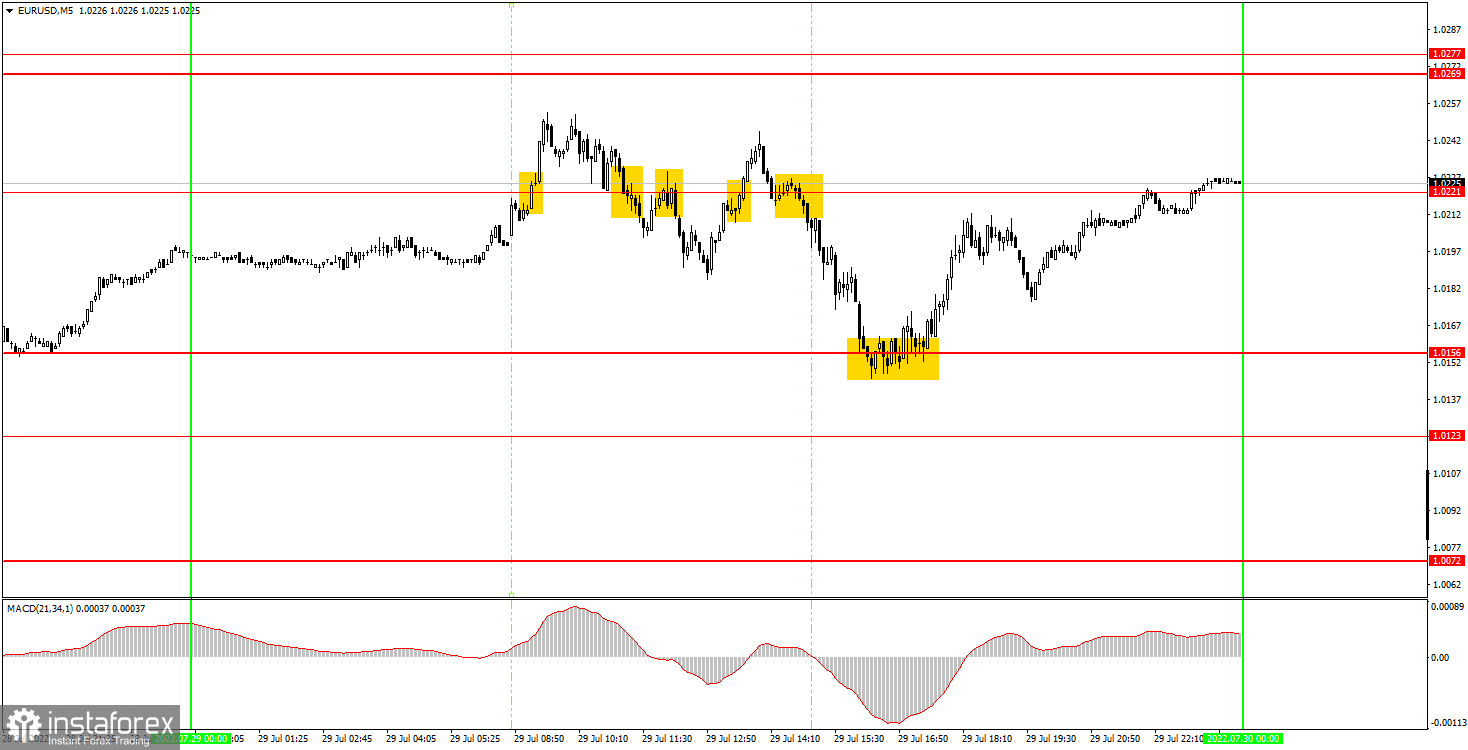Analysis of Friday's deals:
30M chart of the EUR/USD pair

The EUR/USD currency pair continued to trade in a limited price range on Friday. Although at this time there is no classic pronounced flat, there is still no point in denying that there is no trend now either. Thus, novice traders can consider the current movement as a flat. The descending trend line, which gave at least some guidance, has already been canceled, and the price jumped in all directions on Friday. And this, by the way, is another sign of a flat - when the price constantly changes direction during the day. Moreover, one cannot even say that these reversals were provoked by macroeconomic statistics, which were quite numerous on Friday. Most likely, the statistics influenced the pair's movement, but all the key reversals did not occur during the release of a particular report. We draw your attention, in principle, to only two reports. GDP in the second quarter and inflation for July in the European Union. As it turned out, GDP in Europe grew stronger than expected, and in addition, the report for the first quarter was revised in favor of an increase. Thus, the euro had plenty of reasons to show growth, but in the end it did not show it. Consequently, we got another day in our piggy bank, when the pair's movements, to put it mildly, did not correspond to the macroeconomic background.
5M chart of the EUR/USD pair

You can clearly see on the 5-minute timeframe what we meant by saying above that the pair often reversed. The price managed to form five signals around the same level of 1.0221 during the European trading session - a sign of a flat. The movements during the US trading session were more stable and only one signal was formed. Let's sort it out in order. The first two signals around the 1.0221 level were false. In the first case, the price could not move even 15 points in the right direction; in the second case, it still passed the required distance to be able to set Stop Loss to breakeven. Three subsequent signals around 1.0221 should have been ignored. The signal to buy near the level of 1.0156 was formed quite late, but one could still try to work it out, especially since we managed to set Stop Loss to breakeven right away, so there was no risk. As a result, the price returned to the level of 1.0221, and the profit on this deal more than covered the morning loss, and the day ended with a total profit, albeit a small one.
How to trade on Monday:
There is no upward trend or downward trend on the 30-minute timeframe at this time. There is no clear flat either, so the overall technical picture is as confusing and incomprehensible as possible. Two meetings of central banks failed to help traders answer the question of what to do now with the pair, so the incomprehensible movement may continue for some time. On the 5-minute TF tomorrow, it is recommended to trade at the levels of 1.0000, 1.0072, 1.0123, 1.0156, 1.0221, 1.0269-1.0277, 1.0354. When passing 15 points in the right direction, you should set Stop Loss to breakeven. There are no major events or reports planned for Monday in either the US or the EU. Thus, given the general nature of the movement, it is quite possible that the pair will trade reluctantly and mostly sideways.
Basic rules of the trading system:
1) The signal strength is calculated by the time it took to form the signal (bounce or overcome the level). The less time it took, the stronger the signal.
2) If two or more deals were opened near a certain level based on false signals (which did not trigger Take Profit or the nearest target level), then all subsequent signals from this level should be ignored.
3) In a flat, any pair can form a lot of false signals or not form them at all. But in any case, at the first signs of a flat, it is better to stop trading.
4) Trade deals are opened in the time period between the beginning of the European session and until the middle of the US one, when all deals must be closed manually.
5) On the 30-minute TF, using signals from the MACD indicator, you can trade only if there is good volatility and a trend, which is confirmed by a trend line or a trend channel.
6) If two levels are located too close to each other (from 5 to 15 points), then they should be considered as an area of support or resistance.
On the chart:
Support and Resistance Levels are the Levels that serve as targets when buying or selling the pair. You can place Take Profit near these levels.
Red lines are the channels or trend lines that display the current trend and show in which direction it is better to trade now.
The MACD indicator (14,22,3) consists of a histogram and a signal line. When they cross, this is a signal to enter the market. It is recommended to use this indicator in combination with trend lines (channels and trend lines).
Important speeches and reports (always contained in the news calendar) can greatly influence the movement of a currency pair. Therefore, during their exit, it is recommended to trade as carefully as possible or exit the market in order to avoid a sharp price reversal against the previous movement.
Beginners on Forex should remember that not every single trade has to be profitable. The development of a clear strategy and money management are the key to success in trading over a long period of time.
 English
English 
 Русский
Русский Bahasa Indonesia
Bahasa Indonesia Bahasa Malay
Bahasa Malay ไทย
ไทย Español
Español Deutsch
Deutsch Български
Български Français
Français Tiếng Việt
Tiếng Việt 中文
中文 বাংলা
বাংলা हिन्दी
हिन्दी Čeština
Čeština Українська
Українська Română
Română

